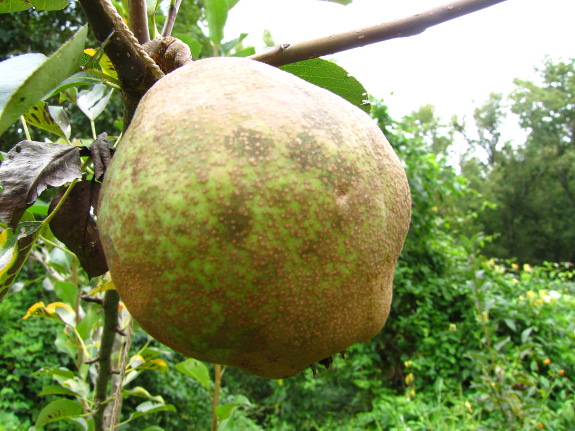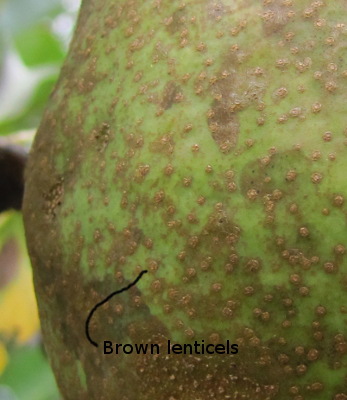
Kieffer and Orient Pears

I've
been waiting with baited breath for our fruit trees to mature enough to
bear, and it seems like every one has had a surprise in store for
me. This year it was the Kieffer Pear that set two fruits a year
earlier than expected.
I watched those
beautiful green pears
swell all summer, and at last saw that their lenticels had turned
brown, meaning that the fruit was fully developed. As with all
storage pears, you have to pick the fruits and then let them ripen for
a few more weeks inside, so again I waited. Finally, the day of
the taste test came. I sliced the pear into quarters and Mark and
I each took a nibble...and just about spit it out. Unfortunately,
the pear I'd been waiting on for the last four years has gritty fruit
with very little taste --- a pear that's best canned, reports the
internet.
 Looking up the pear's sister
tree --- Orient --- turned up the fact that
these two varieties are often planted for their extreme disease
resistance,
but that their fruit is extremely unexceptional. I bought the duo
because they were cheap and I wanted a pear tree, but now I
wish I'd waited a year until I could save the cash for a tree that was
both disease resistant and flavorful. We put in an order for
Starking Delicious Pear (reported to be "Bartlett-quality" and
"virtually blight-free"), so hopefully in another four years, we'll be
tasting a more flavorful fruit.
Looking up the pear's sister
tree --- Orient --- turned up the fact that
these two varieties are often planted for their extreme disease
resistance,
but that their fruit is extremely unexceptional. I bought the duo
because they were cheap and I wanted a pear tree, but now I
wish I'd waited a year until I could save the cash for a tree that was
both disease resistant and flavorful. We put in an order for
Starking Delicious Pear (reported to be "Bartlett-quality" and
"virtually blight-free"), so hopefully in another four years, we'll be
tasting a more flavorful fruit.
Meanwhile, I plan to
graft some tastier varieties onto our existing pear trees. More
on that project in a later post.
Want more in-depth information? Browse through our books.
Or explore more posts by date or by subject.
About us: Anna Hess and Mark Hamilton spent over a decade living self-sufficiently in the mountains of Virginia before moving north to start over from scratch in the foothills of Ohio. They've experimented with permaculture, no-till gardening, trailersteading, home-based microbusinesses and much more, writing about their adventures in both blogs and books.
Want to be notified when new comments are posted on this page? Click on the RSS button after you add a comment to subscribe to the comment feed, or simply check the box beside "email replies to me" while writing your comment.

I'm sorry to hear that your pears aren't very good. I hope that they turn out being pretty good canned. Orchard is on the agenda for Spring, so I'll avoid the Keiffer pears.
Now the other type, they are actually named Orient? Initially I thought you were referring to some type of Asian pear.
Greg --- That's what I thought too, that "Orient" meant it would be an Asian pear. I was excited because I love the taste of Asian pears, but they're very prone to fire blight and hard to grow in warm, wet climates. Unfortunately, Orient and Kieffer are both a hybrid of Asian and European pears that seem to have skipped flavor on both sides of the family tree....
Lisa --- I have read that soil conditions and climate can affect fruit flavor a lot. It's also possible that people were labeling varieties wrong --- there seem to be a lot of pear variety names that mean the same thing and other variety names that refer to more than one type of tree....
I live in SE Georgia and have numerous varieties good for the south. Some have already born some. The funny thing about your article which I saw for the first time today, I added an orient pear to a marginal spot in my yard today. it was a choice between Orient and Keefer, and I chose orient because the tree looked a little healthier than the keefers. I may regret the decision because I was looking for a pear to make pickles with. Orient may not be quite hard enough for the best pickles.
And that leads me to my comment. If you haven't tried pickled pears, you are missing out. Keefers make wonderful crunchy pickled pears. Pineapple pears which are very, very hard as well also make great pickles.
Good fresh eating melting varieties for the deep south are Southern Bartlett (different from Bartlett), Tennessee (best pear I've ever tasted) Golden Boy, Purdue, Scarlett, Leona, Acres Home, Southern Queen and Ayer. Good fresh eating crunchy types for deep south are LeConte, Southern King, Tennosui. Note Tennosui and Southern King are crosses between Tennessee and Hosoui (Japanese type). Tennosui takes after the Asian pear more while Southern King looks like a European pear. For both the texture is like a good Asian pear but the flavor is more European. However both varieties are winning top marks in flavor at fruit growers conventions. My trees are still babies, but the pears produced by my Tennessee pear, their mother variety, are spectacularly flavorful although a bit small.
I forgot an important use for pears in general especially the hard ones. Use them as a as a kind of sweet starchy vegetable in savory meat dishes. I've sliced them up in wedges and cooked them up in a pork and rice dish with lots of herbs and onions. Also cut them up like you would a potato or turnip rood and throw them in with your pork roast. When diced up raw, they can add a crunchy element to a chicken salad. This year I plan to try them in a Chinese style stir fry.
Pick them while they are slightly green so they store a long time in the refrigerator and treat them like a vegetable. They add flavor and a lot of healthy fiber to many savory dishes. God bless.
Marcus
My family has a pear tree, planted in 1964. I'm still not certain if it's Kieffer, Winter Nellis or ???. I was reading the blog about how your pears were not tasty; the pears we have (in north Mississippi) do not taste like traditional pears. They're only sweet, a little juicy, very firm mid to late August. I can the pears using no-sugar added white grape juice and water (pickyourown.com has the recipe). The grape juice gives the pears a bit of added sweetness; also healthy since there's no sugar added. I wished I knew exactly what pear variety I have. I have looked and looked at photos of pears and still uncertain!